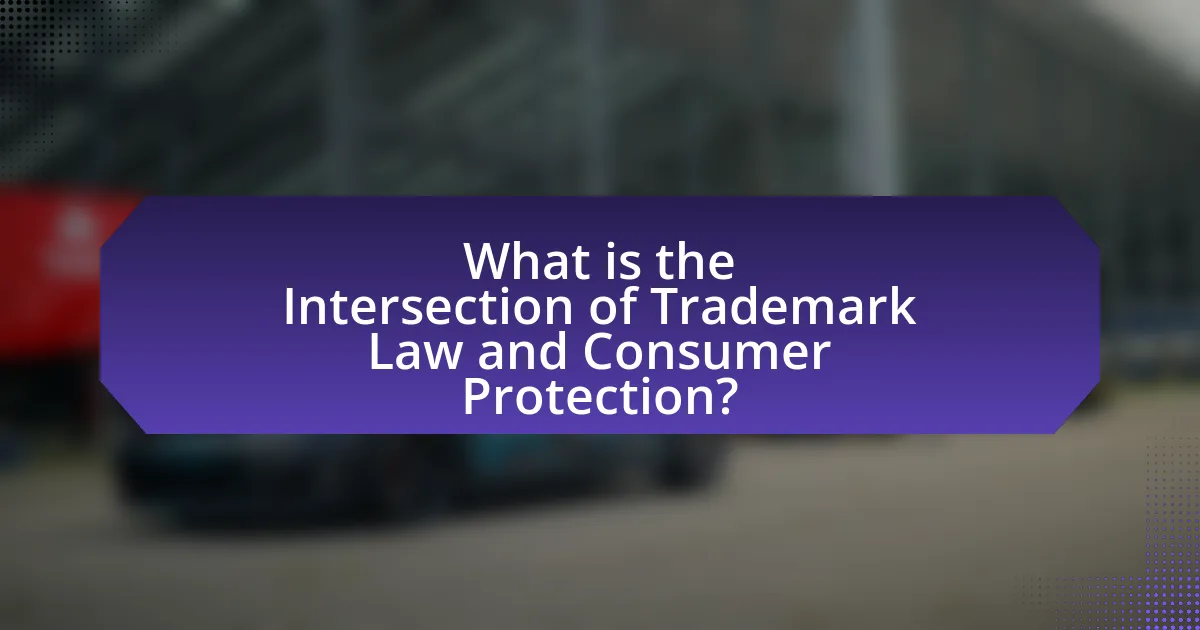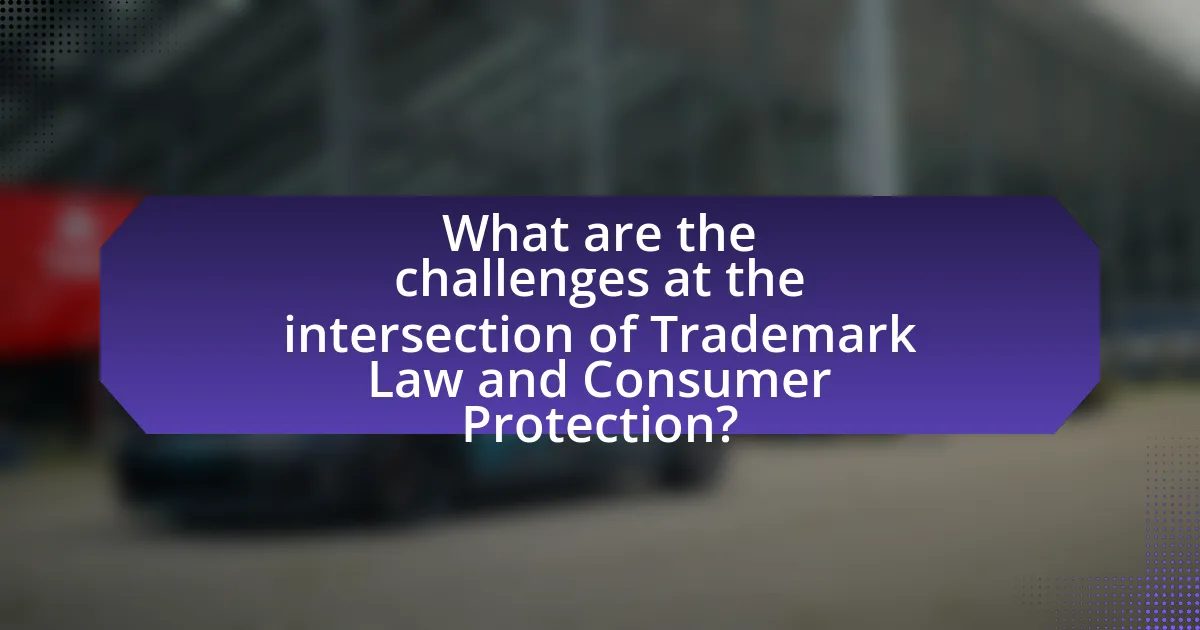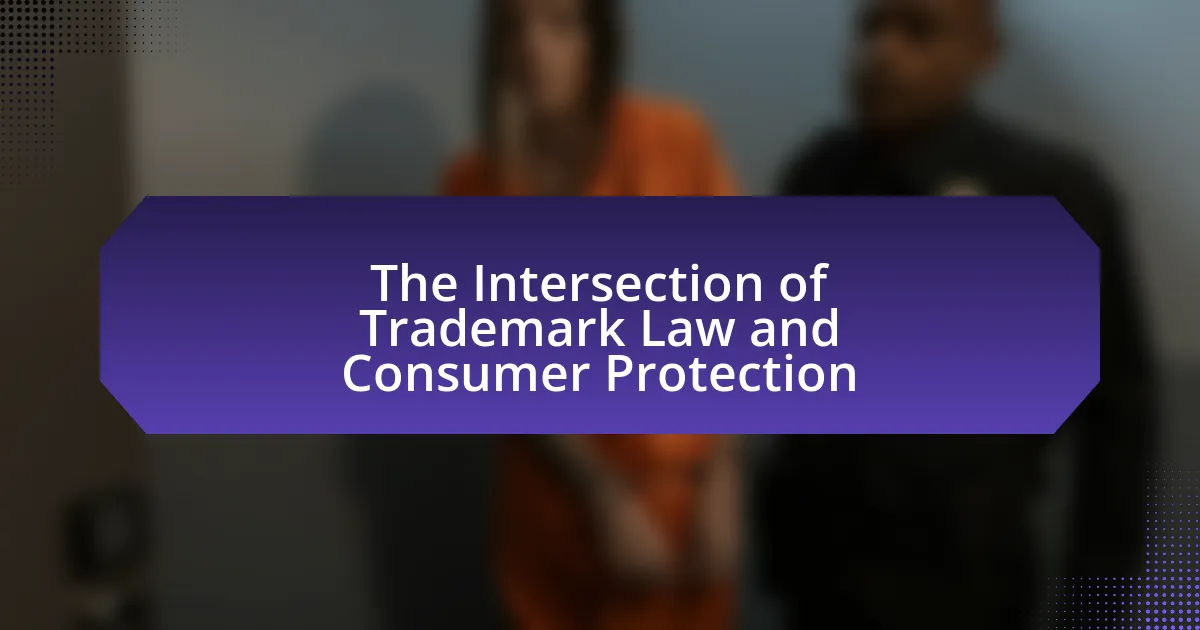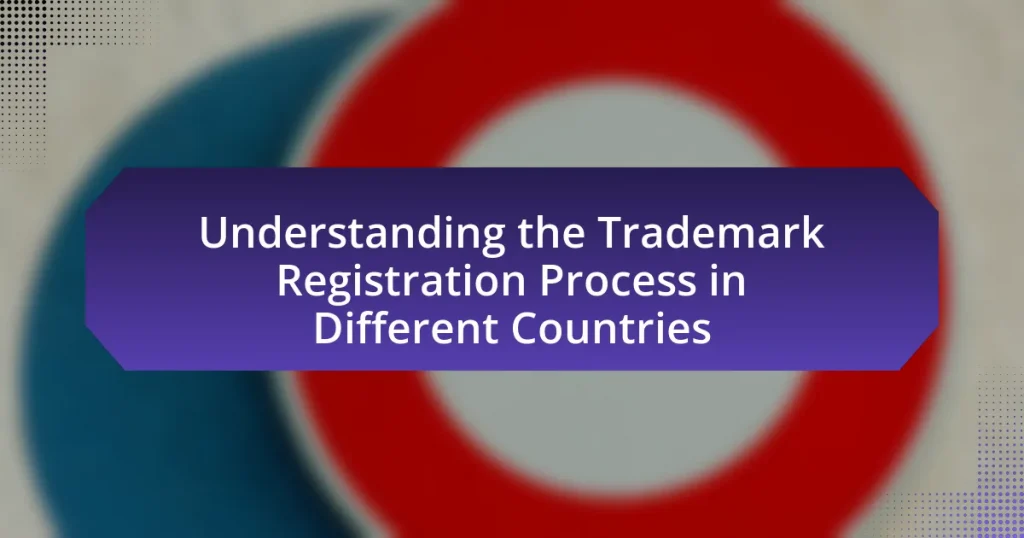The article examines the intersection of trademark law and consumer protection, highlighting how trademark regulations prevent consumer deception and promote fair competition. It discusses the role of trademark laws in safeguarding brand identifiers, which helps consumers identify the source and quality of goods and services. Key principles such as brand identity protection, prevention of consumer confusion, and assurance of product quality are explored, along with the implications of trademark infringement on consumer trust. Additionally, the article addresses the challenges faced in balancing trademark rights with consumer protection needs, the impact of online commerce on trademark issues, and best practices for businesses to enhance consumer trust through effective trademark management.

What is the Intersection of Trademark Law and Consumer Protection?
The intersection of trademark law and consumer protection lies in the regulation of brand identifiers to prevent consumer deception and ensure fair competition. Trademark law protects the rights of brand owners by granting them exclusive rights to use their marks, which helps consumers identify the source of goods and services. This legal framework supports consumer protection by preventing misleading practices, such as counterfeiting and false advertising, which can harm consumers’ interests. For example, the Lanham Act in the United States provides a mechanism for trademark owners to seek remedies against infringement, thereby safeguarding consumers from confusion regarding product authenticity and quality.
How do trademark laws influence consumer protection?
Trademark laws significantly influence consumer protection by ensuring that consumers can identify the source of goods and services, thereby preventing confusion and deception in the marketplace. These laws protect brand names, logos, and other identifiers, which helps consumers make informed purchasing decisions based on their experiences with specific brands. For instance, the Lanham Act in the United States provides a legal framework for trademark registration and enforcement, which helps maintain the integrity of brands and fosters consumer trust. By safeguarding trademarks, these laws reduce the risk of counterfeit products and misleading advertising, ultimately enhancing consumer confidence and safety in their transactions.
What are the key principles of trademark law relevant to consumers?
The key principles of trademark law relevant to consumers include the protection of brand identity, prevention of consumer confusion, and the assurance of product quality. Trademark law safeguards the distinctiveness of brands, allowing consumers to identify the source of goods or services, which is crucial for informed purchasing decisions. This legal framework prevents misleading practices that could confuse consumers about the origin of products, thereby promoting fair competition. Additionally, trademarks serve as a guarantee of consistent quality, as consumers associate specific trademarks with certain standards. These principles are supported by the Lanham Act in the United States, which establishes the legal foundation for trademark protection and consumer rights.
How do trademarks serve to protect consumers from deception?
Trademarks protect consumers from deception by ensuring that products and services are identifiable and distinguishable from one another. This identification helps consumers make informed choices based on the reputation and quality associated with a trademark. For example, a study by the International Trademark Association found that 79% of consumers believe trademarks are important for ensuring product quality. By preventing unauthorized use of trademarks, the law reduces the risk of confusion and fraud, thereby safeguarding consumer interests and promoting fair competition.
Why is the intersection of these two fields important?
The intersection of trademark law and consumer protection is important because it ensures that consumers can make informed choices while safeguarding the integrity of brands. Trademark law provides legal protection for brand identifiers, preventing misleading practices that could confuse consumers. For instance, a study by the International Trademark Association found that 83% of consumers believe trademarks help them identify the source of goods and services, which reinforces trust in the marketplace. This intersection not only protects consumers from deception but also promotes fair competition among businesses, ultimately contributing to a healthier economy.
What risks do consumers face without effective trademark protection?
Consumers face significant risks without effective trademark protection, including exposure to counterfeit goods, misleading information, and compromised product quality. Counterfeit products can lead to financial loss and safety hazards, as these items often do not meet safety standards. For instance, a study by the OECD in 2019 estimated that counterfeit and pirated goods accounted for 3.3% of global trade, indicating a substantial risk of consumers purchasing inferior products. Additionally, without trademarks, consumers may struggle to identify the source of products, leading to confusion and potential harm from fraudulent sellers. This lack of clarity can erode consumer trust in legitimate brands, ultimately affecting market integrity and consumer safety.
How does trademark infringement impact consumer trust?
Trademark infringement significantly undermines consumer trust by creating confusion about the source and quality of products. When consumers encounter counterfeit or misleadingly similar goods, they may mistakenly associate these inferior products with reputable brands, leading to dissatisfaction and distrust. Research indicates that 70% of consumers express concern about the authenticity of products when they suspect trademark infringement, which directly affects their purchasing decisions. This erosion of trust can result in long-term damage to brand reputation and consumer loyalty, as consumers may choose to avoid brands perceived as vulnerable to infringement.

What are the key components of Trademark Law?
The key components of Trademark Law include the definition of trademarks, registration processes, rights conferred by trademarks, enforcement mechanisms, and the duration of trademark protection. Trademarks are symbols, words, or phrases legally registered or established by use as representing a company or product. The registration process typically involves filing an application with a governmental authority, such as the United States Patent and Trademark Office, which examines the application for distinctiveness and potential conflicts with existing trademarks.
Trademark rights grant the owner exclusive use of the mark in commerce, preventing others from using a confusingly similar mark that could mislead consumers. Enforcement mechanisms include litigation and cease-and-desist letters to address infringement. Trademark protection generally lasts as long as the mark is in use and renewal fees are paid, with the potential for indefinite protection if maintained properly. These components collectively ensure that trademarks serve their purpose of identifying and distinguishing goods and services, thereby protecting both businesses and consumers.
What types of trademarks exist and how do they function?
There are several types of trademarks, including word marks, design marks, service marks, collective marks, and certification marks, each serving distinct functions. Word marks protect brand names and slogans, allowing businesses to distinguish their goods or services from others. Design marks safeguard logos and symbols, providing visual identity to brands. Service marks function similarly to trademarks but specifically identify services rather than goods. Collective marks indicate membership in an organization and signify that the goods or services originate from members of that group. Certification marks assure consumers that products meet certain standards or characteristics. Each type of trademark functions to prevent consumer confusion and protect brand integrity, thereby supporting consumer protection by ensuring that consumers can identify the source of goods and services accurately.
What are the differences between registered and unregistered trademarks?
Registered trademarks are officially recognized by a governmental authority, providing legal protection and exclusive rights to the trademark owner, while unregistered trademarks do not have such formal recognition and rely on common law for protection. Registered trademarks benefit from nationwide protection, a presumption of validity, and the ability to sue in federal court, whereas unregistered trademarks may only be protected in specific geographic areas and face a higher burden of proof in legal disputes. Additionally, registered trademarks can use the ® symbol, indicating their registered status, while unregistered trademarks typically use the ™ symbol, signifying common law rights.
How do trademark classifications affect consumer perception?
Trademark classifications significantly influence consumer perception by providing a structured way to categorize goods and services, which helps consumers identify the source and quality of products. When consumers see a trademark, they often associate it with specific characteristics, such as reliability and reputation, based on the classification it falls under. For instance, a trademark in the food category may evoke trust in safety and quality, while a trademark in technology may suggest innovation and reliability. This classification system aids consumers in making informed purchasing decisions, as they rely on the established reputation of trademarks within their respective categories. Research indicates that consumers are more likely to choose products from well-known classifications due to perceived quality and familiarity, reinforcing the importance of trademark classifications in shaping consumer behavior.
How is trademark law enforced to protect consumers?
Trademark law is enforced to protect consumers primarily through the prevention of consumer confusion regarding the source of goods and services. This enforcement is achieved by allowing trademark owners to take legal action against unauthorized use of their marks, which can mislead consumers about the quality or origin of products. For instance, the Lanham Act in the United States provides a framework for trademark registration and protection, enabling trademark holders to sue for damages and seek injunctions against infringing parties. This legal structure helps maintain brand integrity and consumer trust, as evidenced by numerous court cases where companies successfully defended their trademarks against counterfeiters and imitators, thereby safeguarding consumer interests.
What legal remedies are available for trademark infringement?
Legal remedies available for trademark infringement include injunctions, monetary damages, and attorney’s fees. Injunctions can prevent further use of the infringing mark, thereby protecting the trademark owner’s rights. Monetary damages may include actual damages suffered by the trademark owner and any profits gained by the infringer from the unauthorized use. Additionally, courts may award statutory damages, which can range from $1,000 to $200,000 per mark, depending on the circumstances. Attorney’s fees may also be awarded if the case is deemed exceptional, further incentivizing the protection of trademark rights. These remedies are established under the Lanham Act, which governs trademark law in the United States.
How do consumer advocacy groups play a role in enforcement?
Consumer advocacy groups play a crucial role in enforcement by monitoring corporate practices and holding businesses accountable for misleading or harmful actions. These organizations often gather evidence of consumer rights violations, such as false advertising or unsafe products, and may file complaints with regulatory agencies like the Federal Trade Commission (FTC). For instance, in 2020, the FTC took action against companies based on complaints from advocacy groups regarding deceptive marketing practices, demonstrating the effectiveness of these organizations in influencing enforcement actions. By raising public awareness and mobilizing consumer support, advocacy groups enhance regulatory oversight and promote compliance with consumer protection laws.

What are the challenges at the intersection of Trademark Law and Consumer Protection?
The challenges at the intersection of Trademark Law and Consumer Protection include the difficulty in balancing the rights of trademark owners with the need to protect consumers from misleading or deceptive practices. Trademark Law aims to safeguard brand identity and prevent consumer confusion, while Consumer Protection laws focus on ensuring that consumers are not misled about the products they purchase. This creates tension, as aggressive trademark enforcement can sometimes stifle competition and limit consumer choice, while lax enforcement may lead to consumer deception. For instance, cases like the 2017 Supreme Court decision in Matal v. Tam illustrate how trademark protection can conflict with free speech and consumer rights, highlighting the complexities involved in navigating these legal frameworks.
What common issues arise in trademark disputes affecting consumers?
Common issues in trademark disputes affecting consumers include confusion over brand identity, dilution of brand value, and misleading advertising. Consumers may struggle to distinguish between similar trademarks, leading to confusion about the source of goods or services. This confusion can result in consumers purchasing inferior or counterfeit products, which undermines their trust in legitimate brands. Additionally, when a trademark is diluted, the distinctiveness of the brand diminishes, potentially harming consumer perception and loyalty. Misleading advertising can further exacerbate these issues, as consumers may be misinformed about the quality or origin of products, impacting their purchasing decisions.
How do counterfeit goods undermine consumer protection?
Counterfeit goods undermine consumer protection by exposing consumers to substandard products that may pose health and safety risks. These goods often lack the quality assurance and regulatory compliance that legitimate products are required to meet, leading to potential harm. For instance, counterfeit pharmaceuticals can contain harmful substances or incorrect dosages, endangering consumer health. According to the World Health Organization, approximately 10% of medicines worldwide are counterfeit, highlighting the significant risk to consumers. Additionally, counterfeit goods erode consumer trust in brands and markets, as consumers may find it difficult to distinguish between genuine and fake products, further complicating their purchasing decisions.
What role does online commerce play in trademark challenges?
Online commerce significantly complicates trademark challenges by increasing the potential for trademark infringement and dilution. The vast reach of online platforms allows unauthorized sellers to easily use registered trademarks, leading to consumer confusion regarding the source of goods. For instance, a study by the International Trademark Association found that 75% of consumers have encountered counterfeit goods online, highlighting the prevalence of trademark issues in e-commerce. Additionally, the anonymity of online transactions makes it difficult for trademark owners to enforce their rights, as infringers can operate from different jurisdictions, complicating legal recourse. This dynamic underscores the need for robust trademark protection mechanisms in the digital marketplace.
How can consumers protect themselves in the marketplace?
Consumers can protect themselves in the marketplace by being informed about their rights and recognizing legitimate products. Knowledge of trademark laws helps consumers identify authentic brands and avoid counterfeit goods, which can lead to financial loss or safety risks. For instance, the Federal Trade Commission (FTC) emphasizes that consumers should look for registered trademarks and verify seller credentials to ensure product authenticity. Additionally, consumers can report fraudulent activities to authorities, which helps maintain market integrity and protects others from similar issues.
What steps can consumers take to verify trademarks before purchase?
Consumers can verify trademarks before purchase by conducting a search in the United States Patent and Trademark Office (USPTO) database. This database provides access to registered trademarks, allowing consumers to confirm the legitimacy of a brand. Additionally, consumers can check for trademark symbols such as ® for registered trademarks or ™ for unregistered trademarks on products and packaging. Researching the brand’s history and reputation through consumer reviews and third-party websites can also provide insights into the authenticity of the trademark. These steps help ensure that consumers are purchasing genuine products and not counterfeit items, which is crucial for protecting their rights and interests.
How can consumers report trademark violations effectively?
Consumers can report trademark violations effectively by documenting the infringement and submitting a complaint to the appropriate authorities, such as the United States Patent and Trademark Office (USPTO) or the relevant state attorney general’s office. This process involves gathering evidence, including photographs, product descriptions, and any correspondence related to the violation. The USPTO provides a formal complaint process for reporting trademark infringements, which includes filling out a specific form and providing detailed information about the violation. Additionally, consumers can contact the trademark owner directly to inform them of the infringement, as many companies have dedicated teams to handle such reports. This approach not only raises awareness of the violation but may also prompt the trademark owner to take action.
What best practices should businesses follow to align trademark law with consumer protection?
Businesses should implement clear trademark registration processes and actively monitor their trademarks to align trademark law with consumer protection. By registering trademarks, businesses establish legal ownership, which helps prevent consumer confusion regarding the source of goods or services. Active monitoring allows businesses to identify and address potential infringements that could mislead consumers. For instance, a study by the International Trademark Association found that 75% of consumers are more likely to trust brands that actively protect their trademarks, indicating that diligent trademark management enhances consumer confidence and protects brand integrity.
How can businesses ensure compliance with trademark laws?
Businesses can ensure compliance with trademark laws by conducting thorough trademark searches before adopting new marks and regularly monitoring their trademarks for potential infringements. Conducting a comprehensive search helps identify existing trademarks that may conflict with the new mark, thereby reducing the risk of legal disputes. Regular monitoring allows businesses to detect unauthorized use of their trademarks, which is essential for maintaining trademark rights. According to the United States Patent and Trademark Office, failure to enforce trademark rights can lead to loss of those rights. Additionally, businesses should implement internal policies and training for employees regarding trademark usage to foster a culture of compliance.
What strategies can businesses implement to enhance consumer trust through trademarks?
Businesses can enhance consumer trust through trademarks by ensuring consistent quality, transparent communication, and active brand protection. Consistent quality reinforces the reliability of the trademark, as consumers associate the mark with specific standards; for instance, brands like Coca-Cola maintain strict quality control to uphold their reputation. Transparent communication about product sourcing, ingredients, and business practices fosters trust, as seen in companies like Patagonia, which openly shares its environmental impact. Active brand protection, including monitoring for counterfeit products, reassures consumers that the trademark is safeguarded, as demonstrated by luxury brands like Louis Vuitton, which invest heavily in anti-counterfeiting measures. These strategies collectively build a trustworthy brand image, encouraging consumer loyalty and confidence.



